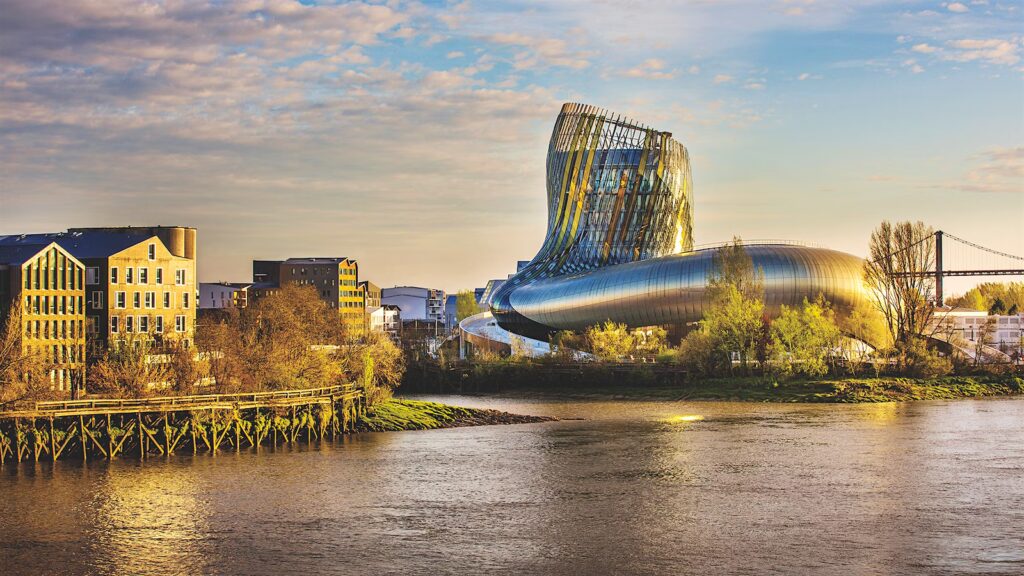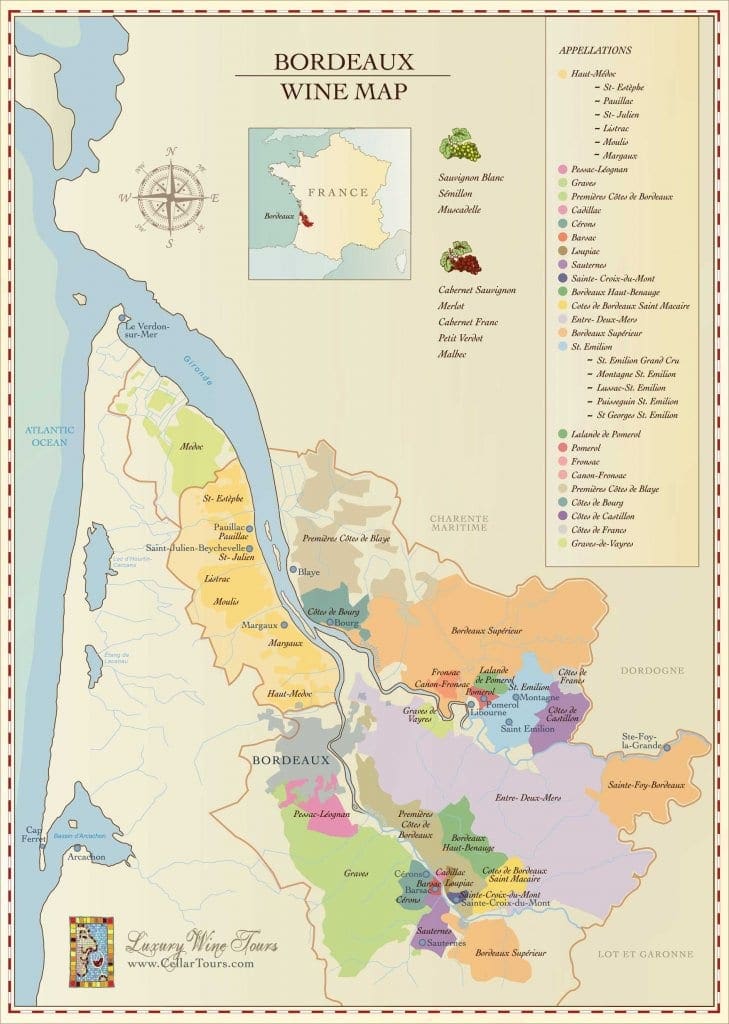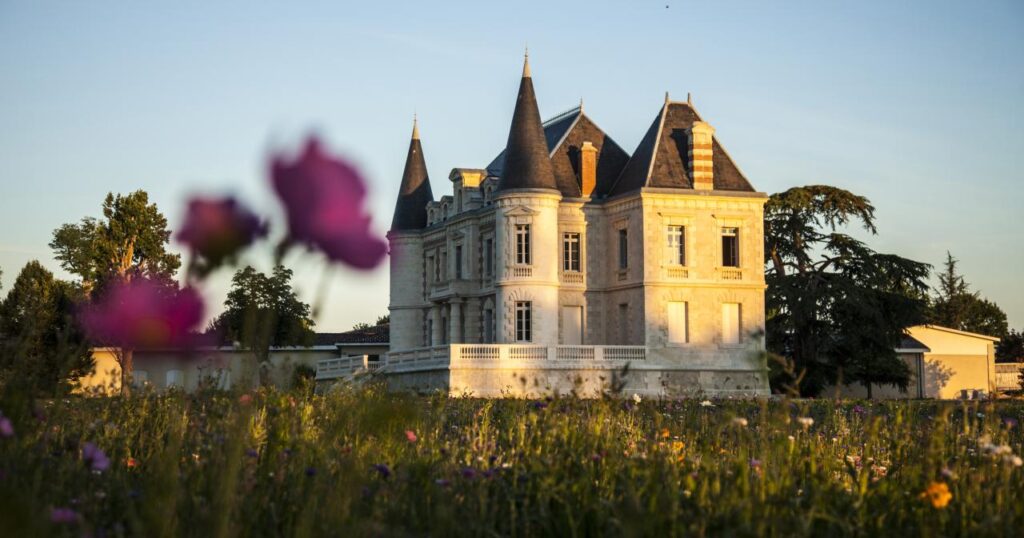
There’s something magical about standing among centuries-old vines, glass in hand, as the golden afternoon light filters through the leaves. Bordeaux isn’t just a wine region—it’s an experience that engages all your senses and creates memories that linger long after your suitcase is unpacked back home. Here is your Bordeaux wine region travel guide, where we will explore wine and more.
The Majestic Bordeaux Wine Country
Stretching across approximately 280,000 acres of rolling countryside, Bordeaux stands as France’s largest wine region, producing millions of cases annually from roughly 6,100 estates. According to Wine Spectator, this impressive wine country is “defined by its history, its blue-chip wines and, like most Old World regions, its complex appellation system through which wines are categorized by geographic origin”.
What makes Bordeaux truly special is its pedigree—a winemaking tradition spanning over 20 centuries. The landscape itself tells a story: from the grand limestone châteaux to the meticulously maintained rows of vines. You can feel the weight of history and tradition in every sip. The terroir here produces an incredible diversity of wine styles from powerful reds to complex whites, sweet nectars, refreshing rosés, and even sparkling options.
Discovering Bordeaux’s Distinctive Wine Regions

This wouldn’t be a true Bordeaux wine region travel guide without talking about the wine appellations found here. Each of Bordeaux’s wine regions offers its own unique character and tasting experience:
Left Bank/Médoc
Home to many of those postcard-perfect châteaux and classified growths, where Cabernet Sauvignon reigns supreme, creating powerful, age-worthy wines with distinct cassis and pencil lead aromas.
Left Bank/Graves
Where excellent red and white wines emerge from gravelly soils, giving the wines a distinctive mineral character.
Right Bank
Including the charming medieval village of Saint-Émilion and prestigious Pomerol, known for luscious, velvety Merlot-based wines.
Sauternes
The magical region where morning mists and afternoon sun create the perfect conditions for noble rot, resulting in some of the world’s most luxurious sweet wines.
Wine critic James Lawrence notes that “the region has also successfully adapted to the demands of our changing world,” particularly in sustainable viticulture. According to the Bordeaux Wine Council, Bordeaux now boasts the highest number of certified sustainable wine producers, with 70% of vineyard area managed under the Haute Valeur Environnementale (HVE) program—perfect for eco-conscious travelers who want to enjoy great wine with a smaller environmental footprint.
Unforgettable Wine Experiences
Bordeaux offers far more than traditional château tours and tastings (though those are certainly wonderful). Today’s wine tourism experiences are creative, immersive, and tailored to all types of travelers:
Bespoke Private Tours
Enjoy privileged access to prestigious estates not typically open to the public, with personal introductions to winemakers and private barrel tastings.
Hands-On Experiences
Try your hand at blending your own Bordeaux wine under the guidance of expert winemakers, or even participate in the harvest if you time your visit right.
Culinary Adventures
Discover the perfect food pairings for different Bordeaux wines through cooking classes, market tours with local chefs, and gourmet picnics among the vines.
Active Explorations
Cycle through the picturesque vineyards of Saint-Émilion, hike among the vines of the Graves region, or take a kayak along the Dordogne River for a unique perspective.
River Wine Cruises
Glide along the Garonne River, stopping at prestigious wine estates accessible from the water—a truly elegant way to experience the region.
Bordeaux’s iconic Cité du Vin, a striking wine museum and cultural center on the banks of the Garonne River, offers an immersive introduction to the world of wine. According to Travel & Leisure, the architecture itself is stunning, “looking almost like a carafe of wine”. This modern landmark has become a must-visit attraction for wine enthusiasts, offering interactive exhibits, tasting sessions, and panoramic views of Bordeaux city from its eighth-floor observation deck.
Unforgettable Château Experiences

Food & Wine magazine highlights several standout châteaux offering exceptional visitor experiences:
Château Lanessan, a stylish Haut-Medoc property that has remained in the same family for eight generations, combines reasonably priced wines with beautiful English gardens and a fascinating equestrian museum.
For something truly special, Château Gruaud Larose in St. Julien offers tours that start in their panoramic tower and descend into ancient cellars. Their two-hour “White Path” tour takes in the grounds and vineyards, offering a comprehensive experience of a classified growth estate.
Wine lovers seeking something different shouldn’t miss Château Guiraud in Sauternes, where you can taste glorious high-end dessert wines in a stunning setting with lovely grounds—the perfect afternoon indulgence.
Saint-Émilion: Medieval Charm Meets World-Class Wine
The medieval village of Saint-Émilion deserves a special mention. Both a UNESCO World Heritage Site and one of Bordeaux’s most celebrated wine appellations, this charming destination offers cobblestone streets, underground monuments, and some of the region’s most celebrated wines.
Walking through Saint-Émilion feels like stepping back in time, with its narrow limestone streets, ancient churches, and spectacular views over the surrounding vineyards. History buffs will appreciate the fascinating 12th-century monolithic church, and foodies might be interested to learn that the first macarons were invented here by nuns in the early 17th century—a delightful sweet treat to enjoy between wine tastings.
Bordeaux’s Remarkable Tourism Evolution
What’s particularly fascinating about Bordeaux is how quickly it has evolved as a tourism destination. Twenty years ago, most vineyards were virtually closed to tourists, with many producers considering tourism “a dirty business.” By 2019, however, Bordeaux welcomed 6.8 million visitors—three times the number from 15 years earlier—who spent $1.6 billion in the region.
Today, many châteaux have embraced tourism as an essential revenue stream, with some family-run estates deriving up to 60% of their income from visitors. This shift has created a wine region that beautifully balances tradition with innovation, offering world-class hospitality alongside centuries of winemaking heritage.
Planning Your Perfect Bordeaux Experience
For a truly exceptional Bordeaux wine experience, consider these insider tips:
When to Visit
Spring (May-June) and fall (September-October) offer ideal weather and the chance to see either flowering vines or the excitement of harvest season.
Home Base
The vibrant city of Bordeaux makes an excellent hub for exploring the surrounding wine regions. Stay in a luxury hotel in a renovated 18th-century mansion for an authentic experience.
Beyond Wine
Balance wine experiences with cultural visits to Bordeaux’s museums, shopping in its elegant boutiques, or long lunches at waterfront bistros.
Your Bordeaux Journey Awaits
Bordeaux has truly transformed itself into a world-class destination that offers the perfect blend of tradition and innovation, luxury and authenticity. Whether you’re a serious wine collector seeking privileged access to legendary First Growths, a food lover eager to explore perfect wine and cuisine pairings, or simply someone who appreciates beautiful landscapes and living history, Bordeaux offers unforgettable experiences for every type of traveler.
While this Bordeaux wine region travel guide is a great place to start, planning a Bordeaux wine adventure requires insider knowledge and connections to unlock the region’s most exclusive experiences. As your luxury travel advisor, I can design a completely personalized Bordeaux itinerary that aligns with your interests, pace, and preferences. From arranging private tastings at prestigious châteaux not typically open to the public, to securing reservations at sought-after restaurants, to organizing unique experiences like helicopter tours over the vineyards or hands-on blending sessions with renowned winemakers—I’ll handle every detail so you can simply savor each moment.
Ready to plan your ultimate Bordeaux wine adventure? Contact Mistral Winds Travel today, and together we’ll craft an extraordinary journey through one of the world’s most celebrated wine regions. Your perfect Bordeaux experience awaits!
Clients will receive extensive guides for their upcoming destinations, but I like to give my tips and tricks to everyone! I hope this can inspire a trip, give you some ideas of new places to visit, and spur your dreams into reality! Check back for updates soon.
welcome to our
home on the web
A cool, dry wind that blows through the Rhone Valley, France towards the Mediterranean Sea. It keeps vines ventilated and dry, leading to the exceptional French gastronomy and wine pairings of the region.
Experience traditional Provençal cuisine and rosé tours in this magnificent wine region.
What is a Mistral Wind?